DUBWIS6 by Glaciers of Ice
I am legitimately proud of this. I haven't got a clue how it happened.
Does it count as 'self promotion' if it's on my own blog?
Wednesday, June 29, 2011
Monday, June 27, 2011
Characterizing the Japanese Music Industry
I've been trying lately, as I move toward the end of my time in Japan (for now) to do a little summing up - to think about what I've learned, how I can structure it meaningfully, and what holes I want to plug before I leave. Much of what I've learned revolves around the daily lives of musicians, but I want to place that within the broader context of the general conditions within which they're working. So what can I say about Japan as a context for the production of music? As an initial stab, the Japanese situation is one of:
1. Intense stratification and hierarchical control. For musicians who want to reach a mass audience, there are no strong alternatives to the major labels and management companies. For a variety of reasons (including strong-arm tactics by dominant management companies and, just maybe, high-level ties to organized crime), it is almost impossible to access television except through these channels. Where in the U.S. we've become used to seeing independent musicians on late-night talk shows, hearing their music on commercials, etc, there's no real equivalent to this in Japan. Meanwhile, for musicians who bow to the structure, management companies tightly control their talent (even those with genuine musical talent), approving and limiting their releases as well as non-music projects.
2. Partly as a result, there is Palpable Contempt for Mass Audiences. This is not a cultural constant - Japanese pop music from the sixties and seventies was of high quality and often aesthetically or culturally progressive. But music of the recent past is simply insulting, pandering to an (admittedly often true) image of mouth-breathing otaku and blandly disinterested housewives. Of course, AKB is the apex of this (the recent CGI affair is only a rather patent manifestation of the plasticine idiocy they represent), but it's everywhere - teenage girls singing meaningless lyrics over cookie-cutter tracks. Even artists who use visuals promising something interesting usually . . . aren't.
3.Thorough Domestication, at least at the top. The very biggest Western artists still get some traction (for instance, currently, Lady Gaga), and there is a genuine 'Korean Wave' of bands like Girls Generation. And if you look at the culture more broadly, of course, there's a huge engagement with, in particular, Western (mostly American) pop, rock, jazz, soul, and hip hop from the fifties through nineties. But charts are dominated by domestic artists. This might not be a problem, maybe not even notable, except that this insularity is self-fulfilling in the export market - the failure of the Japanese pop machinery to engage with global aesthetic developments over the last ten years has left Japanese pop relevant abroad only to a marginal, if not exactly small, group of international otaku. Again, this doesn't apply nearly as much to indie and underground acts, for example bands like Boris, Acid Mothers Temple, and Melt Banana who are active, relevant contributors to global music.
1. Intense stratification and hierarchical control. For musicians who want to reach a mass audience, there are no strong alternatives to the major labels and management companies. For a variety of reasons (including strong-arm tactics by dominant management companies and, just maybe, high-level ties to organized crime), it is almost impossible to access television except through these channels. Where in the U.S. we've become used to seeing independent musicians on late-night talk shows, hearing their music on commercials, etc, there's no real equivalent to this in Japan. Meanwhile, for musicians who bow to the structure, management companies tightly control their talent (even those with genuine musical talent), approving and limiting their releases as well as non-music projects.
 |
| Do you really even need to listen to this? |
3.Thorough Domestication, at least at the top. The very biggest Western artists still get some traction (for instance, currently, Lady Gaga), and there is a genuine 'Korean Wave' of bands like Girls Generation. And if you look at the culture more broadly, of course, there's a huge engagement with, in particular, Western (mostly American) pop, rock, jazz, soul, and hip hop from the fifties through nineties. But charts are dominated by domestic artists. This might not be a problem, maybe not even notable, except that this insularity is self-fulfilling in the export market - the failure of the Japanese pop machinery to engage with global aesthetic developments over the last ten years has left Japanese pop relevant abroad only to a marginal, if not exactly small, group of international otaku. Again, this doesn't apply nearly as much to indie and underground acts, for example bands like Boris, Acid Mothers Temple, and Melt Banana who are active, relevant contributors to global music.
Monday, June 20, 2011
International Transport Volume 5A - Clean it Up And Dub It

(The idea behind these mixes - of pointing out little-known American music for Japanese audiences, and vice versa - has been inconsistently executed. But now we're doing it for real - this is part 1 of a matched set, and the second part should go up in no more than a few days. This one's for my Japanese friends.)
International Transport 5 - Clean It Up and Dub It
ここに集まった欧米に作った曲には、最近も、ちょっと前の曲も入ているのに、ほとんどダッブの生気からインスピレーションもらった。The Weekndは基本的にR&B,ピーキングラライトスはIndie世界から来たん、HolyOtherは多分テクノと言うんだけど、三つは似ているようにダッブ芸実使う。
俺は最近得にテキサスをはじめアメリカの南から2000年代に出たヒップホップにはまっている。”Screw”と言うスタイルは日本にほとんど知られていないけど、最近サイケデリック世界にも音響している。特にSalemというバンドを影響された。スローはキーワード。いわゆる”Syrup”麻薬がこういう雰囲気の作るのに強い影響あった。 ”Still Tippin’”は私が一番好きのScrew風な曲。
ダッブや、Screw、「ノイズ」もこのミックスの中心です。ClamsCasinoと言う、日本にまだ知られていないトラックメイカーはノイズだらけ、けどフックも信じられない。同じ用に、ビッグジャッスの「Dedication 2 Peo」はある表面にきれいの逆けど、美しいになる。
Playlist Next
Playlist Next
Thursday, June 16, 2011
Best Music Podcasts
Note: I now blog at Blownhorizonz.com. It's much prettier to look at, and more focused on fun stuff like weird fiction, extreme music, and awesome art. Also check out my Tumblr at blownhorizonz.tumblr.com.
As a city knit together by public transportation and lots of walking, Tokyo has made me more of a podcast junky than ever. And of course, what I'm looking for most of all is music-related stuff. Strangely, there's not exactly a wealth of greatness out there, but here's what I've found:
Sound Opinions (Itunes)
Sound Opinions is the only podcast I've found that actually engages with music, in the deepest sense - talking about it, interviewing musicians, reviewing history, putting things in context, and making critical judgments. It's fantastic that it exists, but it's a shame it's so unique, particularly since its hosts are well into middle age, and while they tend to have a great sense of perspective, they're not very adventurous.
And if I can resurrect an outdated slur, they're the very definition of "rockists."
Gorilla Vs. Bear
Gorilla Vs. Bear is an amazing site, featuring new tracks daily. But my favorite feature is the monthly mix, which compiles the best stuff from their posts. It's a reminder of how nice it is to put your faith in an expert curator, against the current norm of always being your own DJ.
Altered Zones
Most of what goes for GVSB is true here too, except that Altered Zones hosts a series of guest mixers to produce their monthly mix series. Recent standouts include John McEntire and Ford and Lopatin.
Experience Music Project Oral Histories (Itunes)
Not technically a podcast (it's part of ItunesU) but exactly the sort of thing I'd love to see more of - lineup includes conversations with Krist Novoselic and Henry Rollins.
Dublab (Itunes)
A series of live recordings by of-the-minute bands. As the name implies, skews towards downbeat, lo-fi grooves. I can specifically recommend the great set by L.A. Vampires.
XLR8R (Itunes)
A pretty mixed bag, as they frequently (and surprisingly) throw in some rather lame rock, but I still dip into it every once in a while.
You might have noticed this is a rather short list. It defies sense, but there's a genuine dearth of compelling and creative music podcasts. If you have other suggestions, post them in the comments!
As a city knit together by public transportation and lots of walking, Tokyo has made me more of a podcast junky than ever. And of course, what I'm looking for most of all is music-related stuff. Strangely, there's not exactly a wealth of greatness out there, but here's what I've found:
Sound Opinions (Itunes)
Sound Opinions is the only podcast I've found that actually engages with music, in the deepest sense - talking about it, interviewing musicians, reviewing history, putting things in context, and making critical judgments. It's fantastic that it exists, but it's a shame it's so unique, particularly since its hosts are well into middle age, and while they tend to have a great sense of perspective, they're not very adventurous.
And if I can resurrect an outdated slur, they're the very definition of "rockists."
Gorilla Vs. Bear
Gorilla Vs. Bear is an amazing site, featuring new tracks daily. But my favorite feature is the monthly mix, which compiles the best stuff from their posts. It's a reminder of how nice it is to put your faith in an expert curator, against the current norm of always being your own DJ.
Altered Zones
Most of what goes for GVSB is true here too, except that Altered Zones hosts a series of guest mixers to produce their monthly mix series. Recent standouts include John McEntire and Ford and Lopatin.
Experience Music Project Oral Histories (Itunes)
Not technically a podcast (it's part of ItunesU) but exactly the sort of thing I'd love to see more of - lineup includes conversations with Krist Novoselic and Henry Rollins.
Dublab (Itunes)
A series of live recordings by of-the-minute bands. As the name implies, skews towards downbeat, lo-fi grooves. I can specifically recommend the great set by L.A. Vampires.
XLR8R (Itunes)
A pretty mixed bag, as they frequently (and surprisingly) throw in some rather lame rock, but I still dip into it every once in a while.
You might have noticed this is a rather short list. It defies sense, but there's a genuine dearth of compelling and creative music podcasts. If you have other suggestions, post them in the comments!
Thursday, June 9, 2011
Japanese Horror-Ween 3: Kazuo Umezu
This is roughly my 200th post at Minds Like Knives - I have several unpublished drafts that Blogger counts as posts, so I can't be quite sure, but since I'm excited about this post (as opposed to the alcohol reviews preceding it) let's call it number 200. Yaaaaaay! Now on to the dismemberment.
Kazuo Umezu is a weird one - not just a weird guy, though he would seem to be that, but a weird career arc, which somehow links into the weird arc of Japanese culture over the last fifty years. His first well-known work, and still considered something of a minor classic, is Nekome Kozo, or Cat-Eyed Boy. It's a spooky but fairly innocent story about a supernatural child who goes around bumping into ghosts and spiders and assorted lighthearted symbols of the weird and scary, in a halloween-childish sort of way. It's honestly not to far from what you'd imagine Miyazaki would come up with if he was contracted to write a "ghost story."
But as time went on, Umezu was given the opportunity - maybe even the impetus - to explore some profoundly dark places. I recently picked up 'Kami no Hidari-te Akuma no Migi-te' ('God's Left Hand, Devil's Right Hand'), and it contains three of the more deeply unnerving stories I've come across this side of Lovecraft. Moreover, these are stories that, if not actually intended for children, maintain (intentionally or not) many of the tropes of children's literature, leaving the adult reader with the impression that they've come across something that quite possibly deserves to be banned or burned - except it's four decades too late.
This is the first page of 'Kami no Hidari-te.' It requires a little context - you see, this is a nine year old girl getting her eyes gouged out by a pair of scissors from the inside. It turns out this is a dream sequence, but generally Umezu doesn't pussyfoot or dodge the disturbing elements of his stories. Most notably, the second story in 'Kami' begins with the totally unprovoked plot of a group of third graders to brutally murder their teacher so they can "see her true character" after she dies. Child characters prove themselves capable of astonishing violence again and again in this book - sometimes heroic, just as often cruel and malicious. And even the 'heroic' acts are often justified in ways that would get real-world kids locked up - for instance, setting a bear trap in a woman's car because of something seen in a dream.
What elevates 'Kami no Hidari-te' beyond mere shock, though, is the narrative surrealism. In many cases, the conciets are hard to summarize, which in my book is an endorsement. In the first of the three stories, an extended set piece revolves around the idea that 1) a young girl is being possessed by the vengeful spirits of murdered children, 2) the inside of her body has become a battle ground between those children's murderers and the young girl's brother, who is some kind of dream-warrior, and 3) the dead children are ejecting everything from newspapers to tricycles through her into the world, without killing her.
It's gory to an almost mind-numbing extreme, but the plot keeps things moving along and never allows any image to get stale. The same effect holds throughout the book, especially in the third story, which involves the genuinely surreal and delightfully unexplained flexibility of the boundary between dream and reality. The protagonist (the same young boy from the first two stories) at one point enters a dream state, transforms into a crow to kill a spider-queen by ripping her tongue out, and then awakes to spit out the mangled corpse of a spider.
And as I said, what's most insane about all of this is that it relies so heavily on conceits that imply that the intended audience is preteen. The same young boy character (Sou, meaning roughly "idea") is the protagonist of all the stories. His older sister never believes him when he says he's seen something (in a dream or reality, which ultimately become interchangeable), and adults, similarly, seem to distrust something about him. Both of these (like the inarticulate adults of 'Peanuts') seem intended to appeal to actual ten year old boys. Sometimes the kid protagonist is actually right, but then there's also the time that he murders his third-grade teacher, in the real world, without any remorse or consequences.
In short, if it was ever actually intended for children, this is a deeply fucked up book.
If we're talking about adults, though, it's amazing and highly recommended. This is a recent reprint, with this kickass day-glo cover and a lot of rich and varied partial to full color schemes scattered on the newsprint within. It's a fat book, but even with my middling Japanese it's a pretty quick read (and that's actually another disturbing point, because the simplicity of the language seems to have too-young readers at least partially in mind). Ultimately, if you're sick in the head and enraptured by monsters, death, infestation, mutation, and body trauma, this is an absolute must-have.
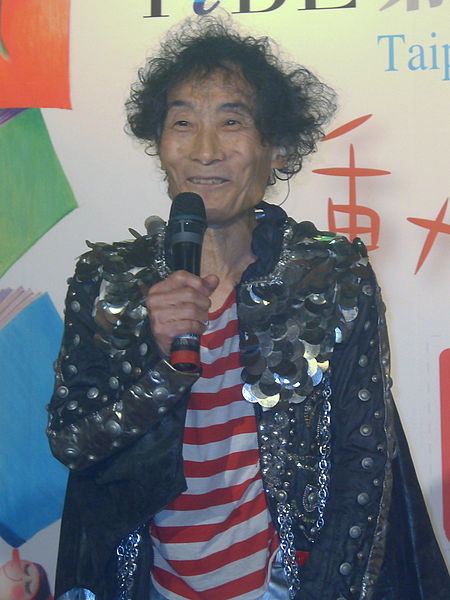 |
| I doubt he dressed like this in the fifties. Or for that matter, the eighties. |
But as time went on, Umezu was given the opportunity - maybe even the impetus - to explore some profoundly dark places. I recently picked up 'Kami no Hidari-te Akuma no Migi-te' ('God's Left Hand, Devil's Right Hand'), and it contains three of the more deeply unnerving stories I've come across this side of Lovecraft. Moreover, these are stories that, if not actually intended for children, maintain (intentionally or not) many of the tropes of children's literature, leaving the adult reader with the impression that they've come across something that quite possibly deserves to be banned or burned - except it's four decades too late.
This is the first page of 'Kami no Hidari-te.' It requires a little context - you see, this is a nine year old girl getting her eyes gouged out by a pair of scissors from the inside. It turns out this is a dream sequence, but generally Umezu doesn't pussyfoot or dodge the disturbing elements of his stories. Most notably, the second story in 'Kami' begins with the totally unprovoked plot of a group of third graders to brutally murder their teacher so they can "see her true character" after she dies. Child characters prove themselves capable of astonishing violence again and again in this book - sometimes heroic, just as often cruel and malicious. And even the 'heroic' acts are often justified in ways that would get real-world kids locked up - for instance, setting a bear trap in a woman's car because of something seen in a dream.
The grotesque sequences just keep coming, and if you've got a taste for artful shock, they alone will keep you engrossed. For instance, while it's been done to death since (see Stephen King's cockroaches), one might consider these sequences of full-body spider infestation visionary.
It's gory to an almost mind-numbing extreme, but the plot keeps things moving along and never allows any image to get stale. The same effect holds throughout the book, especially in the third story, which involves the genuinely surreal and delightfully unexplained flexibility of the boundary between dream and reality. The protagonist (the same young boy from the first two stories) at one point enters a dream state, transforms into a crow to kill a spider-queen by ripping her tongue out, and then awakes to spit out the mangled corpse of a spider.
And as I said, what's most insane about all of this is that it relies so heavily on conceits that imply that the intended audience is preteen. The same young boy character (Sou, meaning roughly "idea") is the protagonist of all the stories. His older sister never believes him when he says he's seen something (in a dream or reality, which ultimately become interchangeable), and adults, similarly, seem to distrust something about him. Both of these (like the inarticulate adults of 'Peanuts') seem intended to appeal to actual ten year old boys. Sometimes the kid protagonist is actually right, but then there's also the time that he murders his third-grade teacher, in the real world, without any remorse or consequences.
In short, if it was ever actually intended for children, this is a deeply fucked up book.
If we're talking about adults, though, it's amazing and highly recommended. This is a recent reprint, with this kickass day-glo cover and a lot of rich and varied partial to full color schemes scattered on the newsprint within. It's a fat book, but even with my middling Japanese it's a pretty quick read (and that's actually another disturbing point, because the simplicity of the language seems to have too-young readers at least partially in mind). Ultimately, if you're sick in the head and enraptured by monsters, death, infestation, mutation, and body trauma, this is an absolute must-have.
Tuesday, June 7, 2011
YoYo-C: Yokohama Reggae
A recommendation straight from Rumi, a nice bit of rootsy reggae from Yokohama's YoYo-C:
Booze Views: Sparx
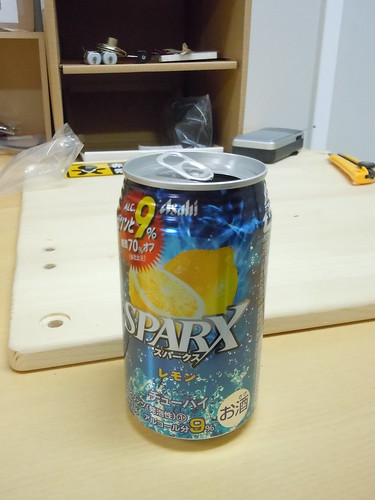 Sadly, there's no direct relation between this beauty and the similarly-named, now-dead-to-me American caffiene-booze cocktail. But they are spiritual brothers, with the shared aim of getting drinkers as quickly and thoroughly messed as possible. At 9% alcohol, this is basically like drinking two Chu-hi at once, with fewer weird stares from the other people at Hello Work.
Sadly, there's no direct relation between this beauty and the similarly-named, now-dead-to-me American caffiene-booze cocktail. But they are spiritual brothers, with the shared aim of getting drinkers as quickly and thoroughly messed as possible. At 9% alcohol, this is basically like drinking two Chu-hi at once, with fewer weird stares from the other people at Hello Work.The tradeoff, of course, is that you can taste the grain alcohol seeping out from behind the chemically-generated Lemon Pledge like some flavor tech's unsuccessfully repressed unconscious memory of an alcoholic absentee father. Drinkable, but only if you have a robust and durable sense of self-worth.
Booze Views: Cocktail Partner - Mango and Orange
The name of this concoction is deceptive for several reasons. It's not a cocktail 'partner,' since it already contains booze - it's just a 'cocktail'. Second, while it emphasizes its fruitiness, it only contains 2.8% fruit juice (if you're annoyed by 'fruit cocktails' in the U.S., Japan is ten times worse about that sort of nonsense).
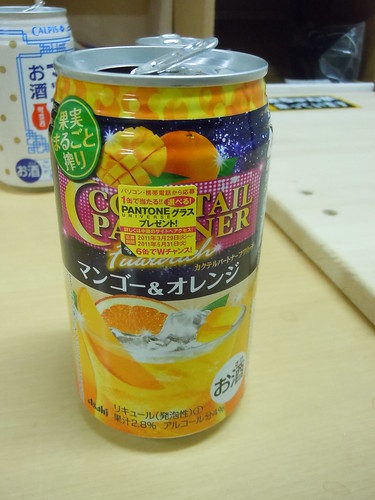 And finally, this drink is only a partner to you, the drinker, in the sense that Ike was Tina Turner's "partner." While the initial sweetness may be beguiling, it's all going to get messy later.
And finally, this drink is only a partner to you, the drinker, in the sense that Ike was Tina Turner's "partner." While the initial sweetness may be beguiling, it's all going to get messy later.
The first noticeable thing is a bitter, tonic-y, almost medicinal taste. It's not overtly disgusting, it's just so utterly fake you'd be as well off pouring Everclear into Kool-Aid.
That said, I finished the whole can.
 And finally, this drink is only a partner to you, the drinker, in the sense that Ike was Tina Turner's "partner." While the initial sweetness may be beguiling, it's all going to get messy later.
And finally, this drink is only a partner to you, the drinker, in the sense that Ike was Tina Turner's "partner." While the initial sweetness may be beguiling, it's all going to get messy later.The first noticeable thing is a bitter, tonic-y, almost medicinal taste. It's not overtly disgusting, it's just so utterly fake you'd be as well off pouring Everclear into Kool-Aid.
That said, I finished the whole can.
Friday, June 3, 2011
Booze Views: Umeshu Jelly
All you need to know about this abomination is that it says you should "Shake Before Drinking."
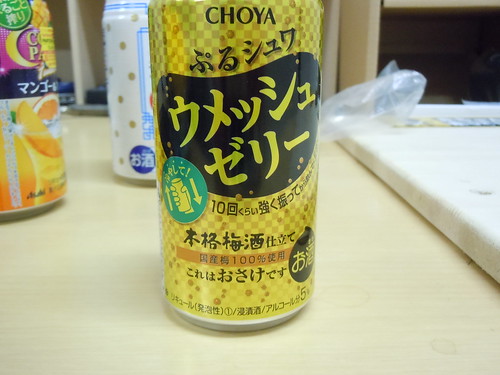
Why, God? Why would you visit such punishment upon mankind? Umeshu itself is a mixed blessing - a plum wine/liqueur that's very delicious and very sweet, like a more natural version of a wine spritzer. It's enjoyable like Diablo II - after a couple of fun hours you're going to feel really bad about yourself.
So anyway, Jelly. It's one of the weirder trends in Japanese drinks, alcoholic and otherwise. People who don't read Japanese are at some point certain to end up with something that looks like grape juice, sports drink, or even cola, and find their first sip full of what feels like curdled milk.
In short, as with most of mankind's sufferings, this is one we have visited upon ourselves. Drinking this is a reminder that I could live in Japan for a decade and there are still things I would never understand. It's also very tempting to see it as a sign that the Japanese are, as a nation and a people, of the devil.

Why, God? Why would you visit such punishment upon mankind? Umeshu itself is a mixed blessing - a plum wine/liqueur that's very delicious and very sweet, like a more natural version of a wine spritzer. It's enjoyable like Diablo II - after a couple of fun hours you're going to feel really bad about yourself.
So anyway, Jelly. It's one of the weirder trends in Japanese drinks, alcoholic and otherwise. People who don't read Japanese are at some point certain to end up with something that looks like grape juice, sports drink, or even cola, and find their first sip full of what feels like curdled milk.
In short, as with most of mankind's sufferings, this is one we have visited upon ourselves. Drinking this is a reminder that I could live in Japan for a decade and there are still things I would never understand. It's also very tempting to see it as a sign that the Japanese are, as a nation and a people, of the devil.
Wednesday, June 1, 2011
Booze Views: Calpis Makkori
I keep things pretty serious around here, so reviews of alcoholic drinks may seem too ephemeral. But let's not forget that this is actually an incredibly depressing subject! You see, I am a deeply flawed human being. Along with billions of others, I deal with my imperfection by periodically blunting my consciousness, papering over the cracks in my own facade with a pleasant haze. In Japan, this is most often done with booze - and as perhaps the world's most consumerist society, booze comes in a dizzying and ever-changing spectrum of varieties and flavors. Won't you come with me, then, for some help in choosing how to reconcile yourself to the inherent contradictions of postmodern risk society?
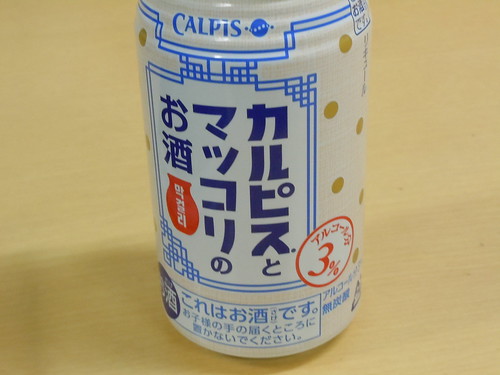
Say hello to Calpis Makkori, the very idea of which is revolting. Calpis is a Gatorade-esque amino-restorative sports drink, and makkori is a milky-white Korean rice liquor, like a thicker version of sake. Makkori has made a huge play for the Japanese booze market lately, reflecting the ongoing, broad "Korean Wave" that has included an incredibly diversity of kimchee brands, bibinba fixings made fresh in every supermarket, and (let's not forget) a seemingly bottomless love of Korean pop stars and actors.
Surprisingly, once you get over the idea of drinking alcohol-laced baby formula, this becomes a cheerful suggestion that another, more harmonious world is possible. It's flat, sweet, and surprisingly fruity. Could be a good summer jam.

Say hello to Calpis Makkori, the very idea of which is revolting. Calpis is a Gatorade-esque amino-restorative sports drink, and makkori is a milky-white Korean rice liquor, like a thicker version of sake. Makkori has made a huge play for the Japanese booze market lately, reflecting the ongoing, broad "Korean Wave" that has included an incredibly diversity of kimchee brands, bibinba fixings made fresh in every supermarket, and (let's not forget) a seemingly bottomless love of Korean pop stars and actors.
Surprisingly, once you get over the idea of drinking alcohol-laced baby formula, this becomes a cheerful suggestion that another, more harmonious world is possible. It's flat, sweet, and surprisingly fruity. Could be a good summer jam.
New Glaciers of Ice: "Low (inst)"
Low (inst) by Glaciers of Ice
What may superficially look like a fun side project or even a "hobby" insidiously links back to my professional life. Making music isn't just important in its own right, but is also a way to better understand the musicians that I write about. But as I get better at it myself, these rationalizations and diversions become less and less important.
What may superficially look like a fun side project or even a "hobby" insidiously links back to my professional life. Making music isn't just important in its own right, but is also a way to better understand the musicians that I write about. But as I get better at it myself, these rationalizations and diversions become less and less important.
Subscribe to:
Posts (Atom)





